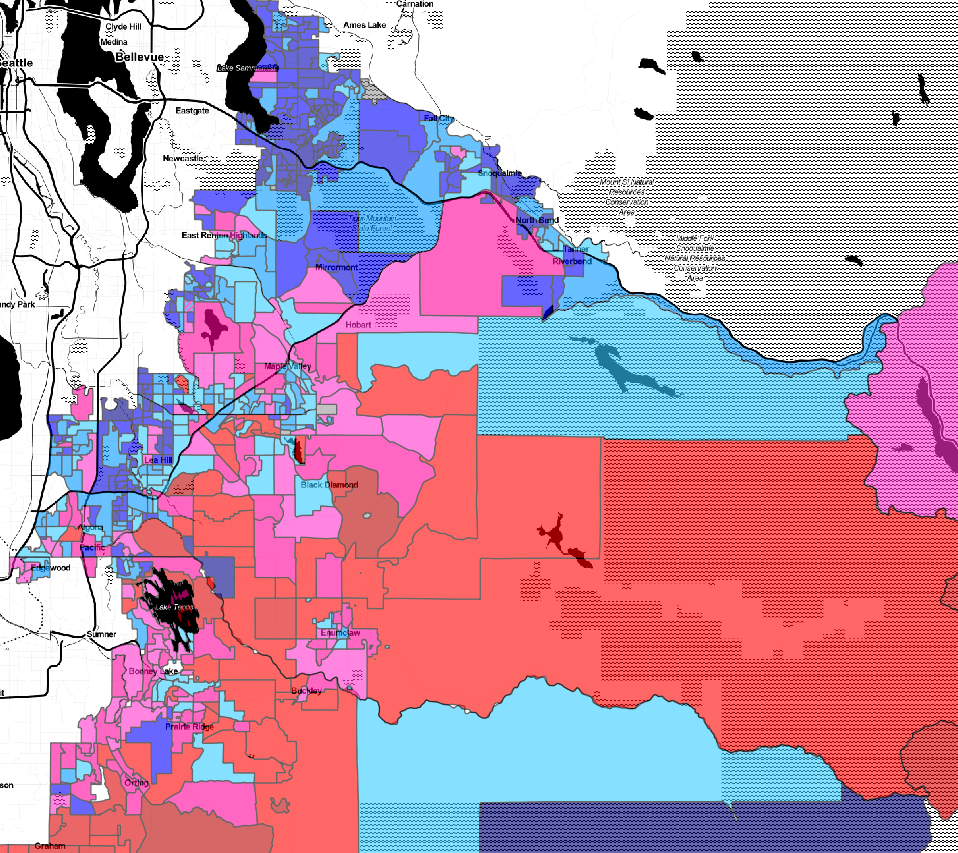This is an edition of Crosscut’s new election newsletter. Sign up here!
Love it or hate it, Washington state’s primary elections system does have one thing going for it: It can tell the future.
In Washington state, we have a few uncommon election laws on the books. First, with no party registration and party preference appearing only nominally on our ballots, voters are completely free to choose their top options among all candidates in a primary. That means, unlike in many other states, a Washington state Democrat is free to cross the aisle to vote for a likable Republican, if they so choose. Second, Washington puts every partisan race on the primary ballot. Even if there is only one Democrat and one Republican – on it goes. Together, that means our primary system gives us a ton of relatively unfiltered information about voter preferences. It’s no surprise, then, that Washington’s primary election is a strong predictor of November results.
In Washington’s 8th District, the future is clear. We are at the outset of what should be one expensive, contentious congressional race.
Spanning from Lake Sammamish to Lake Tapps to Lake Chelan and beyond, Washington’s 8th Congressional District is a place of both eclectic scenery and demographics. It ranges from some of the Seattle region’s wealthier ZIP codes to modest bedroom communities at the edge of the metro — and then on through the Cascade Mountains, past even Wenatchee. It’s a district that sprawls, in every sense of the word.
In the next few months, however, the voters of Washington’s 8th District are going to feel much more claustrophobic. Prepare yourself for enough campaign mail, television advertisements and yard signs to fill Snoqualmie Pass.
With the retirement of incumbent Republican U.S. Rep. Dave Reichert, the 8th District has rocketed to the top of both parties’ national priority lists. Facing a possible loss of the U.S. House, the GOP recruited their top pick – former state Sen. Dino Rossi – in a year where other career-minded Republicans have passed on running. The Democrats, on the other hand, entered the election season with three strong prospects in this district, which leaned toward Clinton in the 2016 presidential race. The primary was virtually guaranteed to be a spectacle.
And so it was. But it was also a deeply informative spectacle. With the post-primary dust settled, we not only know the Democratic nominee who will face Rossi in November. We also have a much clearer sense of the partisan landscape and demographic challenges that will face both combatants.
Yet again, Washington state gets a unique peek at the political future. Here’s five things the primary taught us about the race for the 8th.
1. Democrat Dr. Kim Schrier’s primary win was broad-based … and very 2018.
When I last wrote about the 8th District, the Democratic nominee was a question mark. That matter has been settled. Dr. Kim Schrier, an Issaquah pediatrician, edged out former King County Prosecutor Jason Rittereiser, also of Issaquah. Schrier received 18.7 percent to Rittereiser’s 18.1 percent. Dr. Shannon Hader, an Auburn public health expert, placed third with 12.5 percent.
Some primaries tell us a lot about a candidate’s base of support and potential weak spots. Schrier’s win, however, suggests a healthy, broad base of support. Former prosecutor Rittereiser, an Ellensburg native, did manage to landslide his home county of Kittitas, receiving over 60 percent of the vote. Elsewhere, Schrier mostly pulled off narrow wins, from Seattle suburbs to the Wenatchee area.
Schrier’s win was broad not only geographically, but also demographically. Although some of Schrier’s strongest performances were in high-income suburbs – Sammamish, Issaquah and the East Renton Highlands – her best showing was in the Trump-friendly Pierce County commuter suburb of Orting. Although Rittereiser’s prosecutorial experience likely did appeal somewhat more to moderates, precinct results make it clear that Schrier was far from a niche candidate only appealing to far-left voters. Overall, that’s a good sign for her general election prospects.
Schrier’s win is notable for another reason: It’s very 2018. This is an exceptional year for female candidates in Democratic primaries, with 46 percent of female candidates winning mixed-gender primary contests, as compared to 23 percent of their male counterparts. Her profile as a pediatrician may fit the national narrative, too. While candidates from science backgrounds aren’t faring better than in previous years, polls indicate that health care remains a top vote-getter among Democrats and independents.
In the end, though, candidate biography matters only so much. Above all, the race for the 8th District is about larger political and demographic trends — and that’s where analyzing the primary results gets really interesting.
2. Bad news for Rossi: He’s lost his mojo among high-status suburbanites.
In previous election cycles, Dino Rossi easily won the territory that’s now Washington’s District 8. This year won’t be so easy. Much of that challenge can be attributed to an incredible political sea change in Seattle’s suburbs.
In the George W. Bush era, Dino Rossi might have been the prototypical Eastside conservative. While he has always been to the right of his electorate on most all cultural and policy issues, Rossi succeeded in cultivating an image consonant with suburban moderation. Easygoing, non-conflictual and professionally starched, Rossi had a businesslike cadence that took the edge off his political ideology. He was the sort of conservative swing voters might not want to join for Sunday services, but who they believed would work for Good Governance come Monday.
During Rossi’s previous runs, his hometown — the leafy and moneyed Sammamish — exemplified his base of support. Sammamish, where the median home goes for over $750,000, was in the process of transforming from a Republican stronghold to a swing area. In his 2004 re-election, President Bush carried the city by a narrow margin. But Sammamish was also vehemently supportive of local “business” Republicans like Rossi. In the infamous 2004 governor’s race — which Rossi lost by the slimmest of margins to Christine Gregoire — Rossi won a landslide victory of nearly 22 points (60.9 percent to 39.1 percent) locally.
In the 2018 primary, Rossi absolutely lost his shirt in Sammamish. After voting for Hillary Clinton over Donald Trump by a record 37 percentage points in 2016, the highly educated suburb’s Democratic preference has moved down ticket, as well. Rossi received less than a third of the primary vote here, and Democratic votes outnumbered Republican votes by a margin of 63.3 percent to 26.6 percent. Even the Sahalee Country Club area appears to be leaning blue. The Democratic edge in nearby Issaquah was even greater, and other affluent suburbs — like Snoqualmie Ridge — have also cooled on Rossi.
3. Good news for Rossi: Fewer District 8 votes are high-status suburbanites.
Washington’s 8th District is not what it used to be. Drawn in its previous iteration as a suburban Seattle seat, the current 8th District is a lot more exurban and rural. Among the affluent Eastside suburbs, only Issaquah, Sammamish and the Snoqualmie Valley remain. Even within King County, those communities are outvoted by less lush parts of Auburn and Kent, as well as exurban boomtowns like Covington and Maple Valley. Many of these areas have fairly high incomes, but they have unremarkable rates of college education. As a result, they’re not the strongholds of “Never Trumper” sentiment among swing voters that parts of the old 8th District, like Mercer Island, were.

On top of that, about 40 percent of voters in Washington’s 8th now live outside King County. Just under half of these voters live in the Central Washington portion of the district, which includes the Ellensburg and Wenatchee areas. While this area certainly leans red — Trump won it 53 percent to 37 percent — it’s not the district’s most significant GOP base. That’s in Pierce County. There, 8th Dictrict voters preferred Trump by even more than in the Central Washington part of the district, 53 percent to 36 percent. Driven by strong showings for Trump in peripheral bedroom communities like Bonney Lake and Graham, this area almost singlehandedly counteracted Democratic improvements in other parts of the district.
To win the 8th, the Democrats will need to focus more on places like Bonney Lake than on Sammamish.
4. The primary suggests a (modest) Democratic advantage.
While the primary results and structural factors both suggest a competitive race, the Democrats appear to be at a slight advantage.
As I noted in my post-primary analysis, late ballots trended Republican statewide. That was not as much the case in the 8th District, where Democratic improvements in King County counteracted less favorable trends in other counties. District-wide, Democratic candidates received a cumulative 50.2 percent in the final Primary results to Republicans’ 46.9 percent, with sundry non-partisan rebels receiving 2.9 percent. That’s a modest advantage for Democrats of a bit over three percentage points.
That advantage came entirely from King County, where Democratic ballots outnumbered Republican ones by a margin of 55.6 percent to 41.6 percent, or 14 points. That margin was bolstered by good showings in swingy areas like Covington (a six-point Democratic margin) and Maple Valley (a nine-point Democratic margin), plus solid showings in blue-leaning Auburn and Kent. Republicans enjoyed advantages elsewhere, with a 12-point edge in the Central Washington counties, and a 13-point spread in pivotal Pierce County.
Eagle-eyed observers might wonder whether higher Democratic turnout skews these results. I’ve previously argued that Democrats appear to have benefited from an “enthusiasm gap” in the primary that likely bolstered their showings in Washington’s 3rd and 5th Congressional Districts. While that advantage did shrink in late-arriving ballots, it didn’t disappear. In a higher-turnout general election, it is possible that the “enthusiasm gap” may shrink even further, perhaps swallowing the Democrats’ three-point primary advantage.
Democrats should be less concerned about that in the 8th District, though. An analysis of primary voters suggests that likely Democrats did turn out at somewhat higher rates than likely Republicans, but the advantage was thinner than in the 3rd and 5th. This finding is corroborated by the statewide race for U.S. Senate. There, Democratic ballots outnumbered Republican ballots by 24 points statewide. The 3rd District, where Trump won a modest victory, saw a 10-point Democratic advantage; Eastern Washington’s deeper-red 5th District saw a seven-point margin for Democratic ballots. Despite its Democratic lean at the national level, the 8th District voted Democratic in the U.S. Senate primary by only 6 points. That’s hardly suggestive of a strongly Democratic-skewed electorate. It suggests that the Democrats’ three-point advantage in the 8th District congressional primary is probably real, and not merely an artifact of an excitable Democratic electorate.
5. The Republicans are working against history – but have a shot at making it.
It’s worth concluding with a jarring historical fact. Washington’s 8th District is a special sort of midterm race: an open seat held by the incumbent President’s party, in a district won in the previous election by the incumbent President’s challenger. In the last couple of decades, there have been over 30 congressional races that fit that description. In every one, the challenging party flipped the seat.
If Republicans have anything to get excited about, it’s that Washington’s 8th might break that streak.
The statistical wizards at FiveThirtyEight have been estimating that Rossi has a roughly 50 percent chance of retaining the 8th District for the Republicans. While their algorithm credits Schrier for a strong primary showing, Rossi’s fundraising and the district’s ticket-splitting tendencies give Rossi a modest advantage. While I’m slightly more sanguine about Schrier’s chances than the model, it’s clear that neither party has a decisive advantage in the 8th. This will be a dogfight.
The district, bisected by the Cascade Mountains, basically invites stilted metaphors about blue waves crashing over tall peaks. I’m certainly not one to resist. In 2018, it does appear that the Democratic wave is tall enough to take out some lofty targets. In the 8th District — one of the few remaining competitive seats within view of the Space Needle — it’s possible that Republicans can find high enough ground to survive. But, in what used to be safe territory for the GOP, there’s no denying that the water is lapping at their feet.
Get the latest in election news
In the weeks leading up to each election (and occasionally during the legislative session), Crosscut's Election newsletter will provide you with everything you need to know about races, candidates and policy in WA state.



